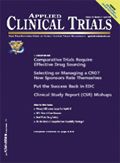The Rarity Value
As EU debates plans for advancing R&D in rare diseases, industry assesses the risks and benefits.
It is essential that rare diseases be made a priority at the European level, in order to deal properly with the needs of several million citizens suffering from misdiagnosis, and thus receiving no treatment to cure their diseases." That is the bold introduction to the document currently being debated in the European Union.

Peter O'Donnell
The European Parliament committee on industry and research is midway through its discussions of a European action plan for rare diseases, and later this year some concrete action may be agreed upon to turn fine words into deliverables. It is a debate that the clinical trials sector might wish to monitor for its own purposes.
The current estimate is that rare diseases altogether affect some 30 million Europeans, but each disease affects only a small number of individuals—sometimes fewer than a dozen in any given country.
So far over 7000 rare diseases are known to exist, and figures before the European Parliament claim that two new pathologies are described every week in medical publications.
"Unlike other public health or research issues, what is at stake here is not merely making up for lost time with regard to a neglected problem, but devising tools or permanent arrangements which will enable the specific features of these diseases to be taken into due account for all time to come," claims Françoise Grossetête, the parliamentarian chosen to lead the discussions in the Parliament.
What she has in mind is simultaneously mobilizing politicians, institutions, patient associations, health professionals, sufferers' associations, carers, researchers, and industry.
A team effort
Cooperation is central to Grossetête's thinking, because the very nature of rare diseases means that expertise in them is limited locally.
"Since no EU member state is capable of combating rare diseases on its own, access to information, diagnostics, carers, and research needs to be organized into coherent and coordinated networks—usable by all those involved—of methodologies and shared approaches at national and European level," she argues. "The Europe-wide approach is therefore essential."
Already, of course, the EU has its orphan medicines legislation, designed to encourage the pharmaceutical industry to develop and market orphan drugs through a combination of tax incentives, protocol assistance, and enhanced commercial exclusivity.
The system is working well, within its limits. The committee for orphan medicinal products held its 100th meeting in March, and nearly 600 products have been granted orphan designation in Europe since the scheme came into effect in 2000.
Grossetête sees other positive trends. Work on rare diseases has benefited the development of therapies for more common diseases, and as the range of therapeutic approaches multiplies with genetic and cellular therapies and 'à la carte' treatments, "the innovative therapies which are developed for rare diseases are a foretaste of the ever more personalized medicine of tomorrow."
In economic terms too, she says, "the explosive growth of opportunities for clinical development in the field of rare diseases opens up fresh prospects." But here she insists on the need for a more collaborative approach.
She is under no illusions about the constraints pharma operates under, so she wants to see a framework that will overcome companies' reluctance to take undue risks.
Cost vs benefit
"Despite the existence of European measures encouraging the development of orphan medicinal products, the pharmaceutical industry is even less willing to take risks in the initial stages of developing treatments (from preclinical to Phase II) than it is with more common diseases.
For the industry, the relationship between financial risks and profit prospects becomes attractive only later on in the process of developing new treatments.
Between proof of concept and the investment of the substantial private funding required before the marketing authorization stage is reached, rare diseases have to go through a death valley much longer than that faced by commoner diseases, with their much greater market potential."
Grossetête's solution is to create new development tools and optimize the development cycle for treatments to minimize costs. At the same time, she favors new methods of sharing risks between private and public funding, which will enable "uneconomic" stages of development to be funded.
The tools she envisages are new networks and closer collaboration among researchers and drug developers. And she warns that otherwise, Europe's drug development prowess will be overwhelmed by international competition.
"If measures are not taken quickly, there is a real risk that certain treatments will never see the light of day and that the only treatments which will be marketed will come from the other side of the Atlantic, at prohibitive prices," she says.
At stake
It is not difficult to discern a two-edged sword flashing amid this utopianism.
The analysis is not, in itself, inaccurate. Of course it is uneconomic to devote scarce resources to projects with little prospect of payback. Ultimately, that road leads to ruin for private-sector firms that depend on a cycle of research funded by revenue. And even publicly-funded research cannot escape the rigors of cost–benefit assessments.
So the prospect of additional aid to fund such research could be good news for companies, good news for independent research, and good news for people suffering from rare diseases.
But—and it is a big but—if the price of additional aid is to be additional interference, or reduced autonomy, then the news may not be so good.
Grossetête may like to make airy allusions to organizing access to information, carers, and research organized into networks "usable by all" and to "shared approaches at national and European level," but the reality on the ground, as anyone in clinical trials knows, is that when things become "usable by all," they are not necessarily of much use to anyone.
And there is a disturbing Orwellian ring to the concept of obliging approaches to be shared at the national and European level.
There is more than intellectual property issues at stake here. The very foundations of intellectual freedom can be shaken by an imposition of dirigisme.
Researching treats recession
By an agreeable coincidence, a similar theme was recently addressed by another senior EU figure.
The EU Commissioner for Science and Research, Janez Potocnik, took advantage of an early March meeting of EU ministers responsible for industry and research to call for tough action in defense of research budgets.
He was commenting on the impact of the credit crunch, recession, and the economic and financial uncertainties, which are, of course, having their impact on companies and clinical trials professionals around the world too.
His message was clear. There is a serious crisis, but there is a way out, and research and innovation are part of it. Building up European research is a major part of the solution, he insisted.
"A reinforced and coherent effort on research and innovation, today more than ever, will bring us on the road to a low carbon, knowledge-intensive economy. It will help us to come out stronger of the crisis when the economy picks up again," he argued.
The Commissioner acknowledged that the pressure for quick fixes can often make it difficult to keep in mind the longer-term priorities for a real, sustainable recovery. But this is what research ministers should be telling their governments, he recommended.
Potocnik also had his own take on the current controversies over the possible merits of a return to protectionism. Protectionism is the wrong answer, in science as in trade, he emphasized. "We should strengthen our coordination and cooperation at the EU level in order to make the most out of our investments."
Warning of the danger of "research nationalism," he called for better coordinated research investments and for encouraging companies and universities to compete and cooperate across Europe.
Patient rights
The EU is also embroiled in one of its most intense debates for years over how to ensure fair treatment at the European level for patients.
During March, the European Parliament debated more than 600 amendments of plans for patients to obtain treatment outside their own member state. It is a delicate balance, because while the freedom to seek services anywhere in the EU is one of its central tenets, allowing patients to choose where they seek reimbursed care risks major upsets to the national budgets that health care in the EU still depends on.
Remarkably, among the hundreds of pages of documents that the debate has generated, there is only one mention of clinical trials.
One of the leading parliamentarians in the debate proposed that there should be support for "cooperation among member states to share experiences and information (e.g., about best-practice, treatments available, trials, and results from research projects) and thus contribute to an improved quality and safety of health care throughout the EU."
Clearly, in terms of broad European political thinking, clinical trials still have only a very low profile in health care matters. There are times when rarity is not an asset.
Peter O'Donnell is a freelance journalist who specializes in European health affairs and is based in Brussels, Belgium.

FDA Fast Tracks Johnson & Johnson’s Nipocalimab for Fetal Neonatal Alloimmune Thrombocytopenia
March 27th 2024Johnson & Johnson is moving forward with a pair of Phase III trials of nipocalimab to reduce the risk of fetal neonatal alloimmune thrombocytopenia in alloimmunized pregnant patients.